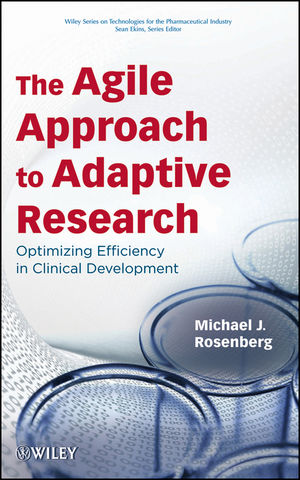The Agile Approach to Adaptive Research: Optimizing Efficiency in Clinical DevelopmentISBN: 978-0-470-24751-8
Hardcover
304 pages
February 2010
 |
||||||
Acknowledgments.
1 Opportunity for Efficiency.
The Adaptive Solution.
An Industrial Success Story.
Signs of Trouble Ahead.
Converging Challenges.
The Struggle to Replace Lost Revenues.
Clinical Research is the Key.
Behind the High Costs of Clinical Development.
High Costs and Increasing Prices.
Growing Pressures Mandate Greater Efficiency.
The High Risk of Current Development Practices.
Economic Consequences of Faster Clinical Development.
Thriving in a New Era.
References.
2 Defining and Extending the Adaptive Approach.
The Adaptive Concept.
Knowledge, Time and Decision-Making.
The Value of Early Knowledge.
The Spectrum of Design and Operational Adaptations.
Maximizing the Adaptive Approach: Agile Clinical Development.
Measure Performance in Real-time.
Metrics in Action.
Right Information to the Right Eyes at the Right Time.
Make Timely Decisions.
Organize Work in Lean Processes.
Rework in Clinical Studies.
Backflow of Patient Data.
Match Technology with Tasks.
Objections to Adaptive Methods.
Integrity and Validity.
The Regulatory Environment.
The Complexity of Clinical Research.
Conclusion.
References.
3 Design Adaptations Part One: Finding the Right Dose.
Background.
Types of Design Adaptations.
Order of Discussion.
Dosing Nomenclature.
Determining Maximum Safe Dose.
Single Arm.
Continual Reassessment Method.
Other Bayesian Dose-Finding Methods.
Determining Optimal Dose (Pruning).
Multiple Arms.
Improvements over Conventional Approaches to Dose Finding.
Dose Selection in Practice.
Optimizing Dose Selection.
Minimizing Costs versus Maximizing Information.
Surrogate Endpoints.
Conclusion.
References.
4 Design Adaptations Part Two: Additional Design Changes.
Sample-Size Reestimation.
The Trouble with Planning Estimates.
The High Cost of "Underbuilt" Studies.
The Benefits of Reestimation and Rightsizing.
Reestimation and Trial Stages.
Rules to Restrict Reestimation.
Adjusting Sample Size for Nuisance Parameters.
Seamless Designs: Combining Multiple Phases.
When to Consider Seamless Studies.
Seamless Phase I/Phase II Trials.
Seamless Phase II/Phase III Trials.
Planning Issues in Seamless Trials.
Phase I-II-III Designs.
Adaptive Randomization.
Response-Adaptive Randomization.
Other Forms of Adaptive Randomization.
Other Types of Design Adaptations.
Noninferiority-to-Superiority Design.
Adaptive Hypotheses and Subpopulations.
Treatment Switching.
Conclusions.
References.
5 Operational Adaptations.
Design and Operational Adaptations.
The Nature and Significance of Operational Adaptations.
Implementing Operational Adaptations.
Enrollment and Other Site Issues.
Data Quality.
Monitoring.
Site Closeout and Database Lock.
Supporting Functions for Efficient Operations.
The Bottom Line.
References.
6 Agile Clinical Development.
Benefits of Agile Development.
A Development Example.
Program Planning.
Safety Testing (Phase I).
Design.
Planning.
Operational Considerations.
Putting the Plan into Action.
Benefits Realized.
Transition to Dose-Finding Study.
Dose Finding (Phase II).
Design.
Planning.
Operational Considerations.
Putting the Plan into Action.
Benefits Realized.
Transition to Confirmatory Studies.
Confirmatory Testing (Phase III).
Design.
Planning.
Operational.
Putting the Plan into Action.
Benefits Realized.
Transition to Regulatory Filings.
Summing Up: The Power of Agile Development.
7 Planning Adaptive Programs.
Determining Design Adaptations and their Requirements.
Determining Operational Requirements to Support Design Adaptations.
Ensuring the Ability to Meet Operational Requirements.
The Importance of Programmatic Thinking.
Looking Ahead.
Advisory and Oversight Groups.
Optimizing the Planning Process.
Regulatory Discussions.
Contingency Planning.
Planning Tools and Techniques.
Decision Trees.
Simulation.
Uncertainties in Clinical Research.
Simulation Tools.
Simulation Step by Step.
The Limitations of Simulation.
Conclusions.
References.
Sources of Simulation Software.
8 Statistics and Decision Making in Adaptive Research.
The Frequentist Approach.
What Frequentist Results Say about the Results of a Clinical Study.
Using Frequentist Results to Make Decisions Based on Individual Trials.
Other Issues with Frequentist Methods.
The Bayesian Approach.
Prior Distributions.
How Bayesian Statistics Works.
Bayesian Statistics in the Real World.
Bayesian Methods in Clinical Research.
Comparing Bayesian and Frequentist Methods.
Prior Distributions.
The Pharma Context.
Learning and Confirming.
Ethical and Operational Issues.
Regulatory Considerations.
Conclusions.
Frequentists, Bayesians, and Pragmatists.
References.
9 The Agile Platform.
Essential Types of Data.
Management Cycles in Clinical Studies.
The Common Platform for Design and Operational Adaptations.
Data Capture.
Data-Capture Technologies.
The First Generation.
The Second Generation.
The Third Generation.
Data Cleaning and Validation Technology.
Data Analysis Tools.
Randomization.
Site Management.
Supply-Chain Management.
Communications.
Conclusions.
References.
10 The Future of Clinical Development.
Is Restructuring an Alternative to Improving Clinical Development?
Greater Efficiency: Changes that Everyone Can Applaud.
Biotechs and Emerging Low-Cost Competitors.
Globalization, Offshoring, and Outsourcing.
Managing More Complex Trials.
Individualized Medicine Demands Greater Efficiency.
A More Important Role for Postmarketing Studies.
The Reward for Greater Efficiency.
Financial Implications of the Agile Approach.
Financial Implications of the Agile Approach for the Drug Industry.
A Brighter Future for Clinical Development.
First Steps toward Agile Development.
An Eight-Point Program for Embracing the Adaptive Approach.
References.
Index.



